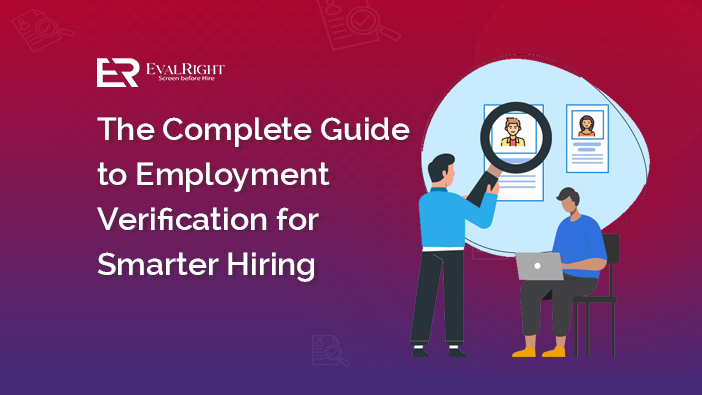The Complete Guide to Employment Verification for Smarter Hiring
The Complete Guide to Employment Verification for Smarter Hiring
Introduction to Employment Verification
Employment verification has become a critical step in the hiring process for companies aiming to make smarter and more informed hiring decisions. It involves verifying a candidate’s past employment, education, and sometimes other aspects of their background to ensure that they are qualified and trustworthy for the role they are applying for. In today’s competitive job market, it’s essential to verify the credentials and experience of potential employees before bringing them on board.
By verifying a candidate’s employment history, companies can minimize hiring risks and protect themselves from potential fraud or misrepresentation. With a structured employment verification process, businesses can streamline their hiring strategies, ensuring they select the most suitable candidates for their roles.
Why Employment Verification is Essential for Smarter Hiring
Employment verification is not just a formality; it’s a crucial step that ensures a company hires candidates who truly possess the skills, qualifications, and experience they claim to have. This process helps in mitigating risks such as:
- Hiring Fraud: With job seekers sometimes exaggerating or falsifying details on their resumes, verification helps in confirming the authenticity of their claims.
- Reducing Turnover: Proper employment verification ensures you hire candidates who are genuinely fit for the role, reducing the likelihood of turnover.
- Maintaining Company Reputation: By hiring competent and honest employees, companies can maintain a positive brand reputation, which is crucial in today’s market.
Incorporating employment verification into the hiring process leads to smarter hiring decisions, enabling companies to build a strong and reliable workforce.
The Legal Framework Surrounding Employment Verification
Understanding the legalities involved in employment verification is vital for businesses. Employers must comply with laws and regulations such as:
- Fair Credit Reporting Act (FCRA): This governs how background checks, including employment verifications, can be conducted.
- Equal Employment Opportunity Commission (EEOC) Guidelines: Employers must ensure that their verification process doesn’t discriminate against any candidate based on race, gender, religion, or other protected characteristics.
- Data Protection Laws: GDPR in Europe and CCPA in California require employers to handle employee data with care, ensuring privacy and confidentiality.
Familiarity with these regulations helps employers conduct employment verifications legally and ethically.
Different Types of Employment Verification
There are various types of employment verification methods, each serving a specific purpose in the hiring process:
Past Employment Verification
This involves confirming the candidate’s job titles, duration of employment, and responsibilities at previous jobs. It helps verify if the candidate has the experience they claim.
Education Verification
Some positions require specific degrees or certifications. Education verification confirms whether the candidate has obtained the educational qualifications they list on their resume.
Reference Checks
Reference checks involve speaking with a candidate’s former supervisors, colleagues, or mentors to gain insight into their work ethic, skills, and overall performance.
How Employment Verification Works
The employment verification process typically involves the following steps:
- Gathering Information: Employers collect the candidate’s work history, education, and references.
- Verification: The employer or a third-party verification service contacts the candidate’s previous employers, schools, and references to verify the information provided.
- Reviewing Results: Any discrepancies are noted, and the employer decides whether to proceed with the hiring process.
Key Benefits of Employment Verification
Employment verification offers several advantages:
- Accuracy: Ensures all information provided by the candidate is truthful.
- Quality Assurance: Helps in selecting candidates with the right skills and experience.
- Risk Mitigation: Reduces the risk of fraud, theft, or other issues arising from hiring an unqualified candidate.
Common Methods of Employment Verification
Employers can verify employment through:
- Direct Communication with Previous Employers: This traditional method involves calling or emailing a candidate’s past employers for confirmation.
- Using Employment Verification Services: These services specialize in conducting verifications efficiently and accurately.
How Technology is Changing Employment Verification
Modern technology has revolutionized employment verification by introducing:
- Automated Verification Tools: These tools can cross-check information provided by candidates quickly, ensuring accuracy.
- Digital Verification Platforms: Secure, cloud-based platforms store verification data, making the process faster and more efficient.
The Role of Social Media in Employment Verification
Social media platforms, especially LinkedIn, have become valuable tools in employment verification. Employers can cross-check a candidate’s work history, skills, and professional connections to verify their credentials.
Challenges Faced During Employment Verification
Some common challenges include:
- Incomplete or False Information: Candidates may provide inaccurate or incomplete details, requiring additional verification.
- Slow Response Times: Some past employers may delay responding to verification requests, prolonging the hiring process.
How Long Does Employment Verification Take?
The time required for employment verification varies depending on factors such as:
- The complexity of the candidate’s employment history
- Response times from previous employers
- The verification method used
Cost of Employment Verification
The cost of employment verification can vary significantly, ranging from as little as $30 to over $100 per candidate, depending on the depth of the verification process and the service provider.
Employment Verification Best Practices
For an efficient employment verification process:
- Start early: Begin verification as soon as possible in the hiring process.
- Use multiple verification methods: Combine different types of checks to ensure accuracy.
- Stay compliant: Always adhere to legal requirements to avoid potential lawsuits.
Employment Verification and Background Checks: The Differences
Employment verification focuses specifically on a candidate’s job history and qualifications, while background checks encompass a broader range of information, such as criminal records, credit history, and personal references. FAQs
How long does employment verification typically take? Employment verification usually takes 3-5 business days but can vary based on response times from previous employers and the verification method used.
Can employment verification be done for international candidates? Yes, many employment verification services offer international verification, but it may take longer due to differences in time zones and communication barriers.

